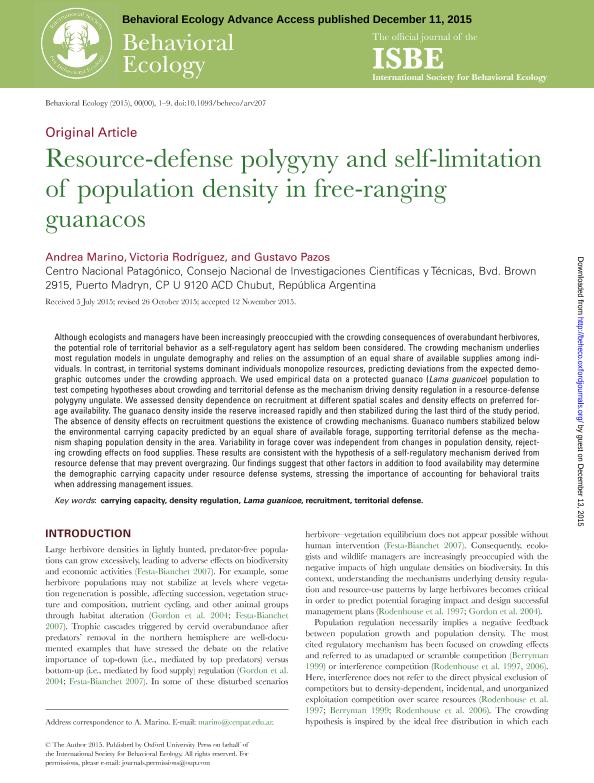Artículo
Resource-defense polygyny and self-limitation of population density in free-ranging guanacos
Fecha de publicación:
01/2016
Editorial:
Oxford Univ Press Inc
Revista:
Behavioral Ecology
ISSN:
1045-2249
e-ISSN:
1465-7279
Idioma:
Inglés
Tipo de recurso:
Artículo publicado
Clasificación temática:
Resumen
Although ecologists and managers have been increasingly preoccupied with the crowding consequences of overabundant herbivores,the potential role of territorial behavior as a self-regulatory agent has seldom been considered. The crowding mechanism underlies most regulation models in ungulate demography and relies on the assumption of an equal share of available supplies among individuals. In contrast, in territorial systems dominant individuals monopolize resources, predicting deviations from the expected demographic outcomes under the crowding approach. We used empirical data on a protected guanaco (Lama guanicoe) population to test competing hypotheses about crowding and territorial defense as the mechanism driving density regulation in a resource-defense polygyny ungulate. We assessed density dependence on recruitment at different spatial scales and density effects on preferred forage availability. The guanaco density inside the reserve increased rapidly and then stabilized during the last third of the study period. The absence of density effects on recruitment questions the existence of crowding mechanisms. Guanaco numbers stabilized belowthe environmental carrying capacity predicted by an equal share of available forage, supporting territorial defense as the mechanism shaping population density in the area. Variability in forage cover was independent from changes in population density, rejecting crowding effects on food supplies. These results are consistent with the hypothesis of a self-regulatory mechanism derived fromresource defense that may prevent overgrazing. Our findings suggest that other factors in addition to food availability may determine the demographic carrying capacity under resource defense systems, stressing the importance of accounting for behavioral traits when addressing management issues.
Palabras clave:
Carrying Capacity
,
Density Regulation
,
Lama Guanicoe
,
Territorial Defense
Archivos asociados
Licencia
Identificadores
Colecciones
Articulos(IPEEC)
Articulos de INSTITUTO PATAGONICO PARA EL ESTUDIO DE LOS ECOSISTEMAS CONTINENTALES
Articulos de INSTITUTO PATAGONICO PARA EL ESTUDIO DE LOS ECOSISTEMAS CONTINENTALES
Citación
Marino, Andrea Ivana; Rodriguez, Maria Victoria; Pazos, Gustavo Enrique; Resource-defense polygyny and self-limitation of population density in free-ranging guanacos; Oxford Univ Press Inc; Behavioral Ecology; 27; 3; 1-2016; 757-765
Compartir
Altmétricas




